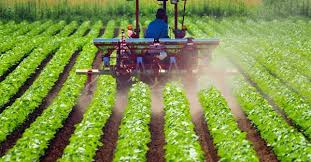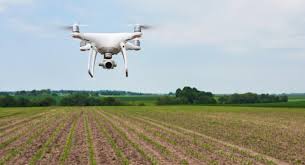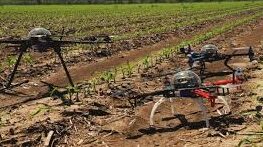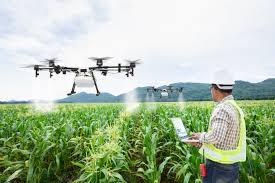Precision agriculture cropping systems represent a transformative approach in modern farming, integrating advanced technologies to enhance efficiency and sustainability. This innovative methodology leverages data-driven insights, enabling farmers to make informed decisions about crop management and resource allocation.
By utilizing tools such as GPS, drones, and sensors, precision agriculture enables a more precise understanding of field variability, allowing farmers to tailor their practices to the specific needs of different areas within a field. This level of customization leads to optimized input usage, reducing waste and minimizing environmental impact.
The concept of precision agriculture emerged in response to the challenges faced by the agricultural sector, including the need to increase food production while conserving natural resources.
As global population growth continues to exert pressure on food systems, traditional farming methods often fall short in meeting the rising demand. Precision agriculture cropping systems offer a solution by enhancing productivity through better resource management.
For instance, farmers can utilize soil moisture sensors to monitor irrigation needs accurately, ensuring that crops receive the optimal amount of water without over-irrigation. This not only improves crop health but also conserves water resources.
Moreover, precision agriculture cropping systems foster sustainability by promoting practices that reduce chemical use and environmental degradation. By employing variable rate technology, farmers can apply fertilizers and pesticides more accurately, targeting specific areas that require treatment rather than blanket applications across entire fields. This targeted approach minimizes chemical runoff, protecting surrounding ecosystems and preserving soil health.
In addition, precision agriculture encourages practices such as cover cropping and crop rotation, which contribute to soil fertility and biodiversity. These practices not only enhance the resilience of farming systems but also support long-term sustainability in agricultural production.
The adoption of precision agriculture cropping systems is further driven by advancements in technology. The proliferation of data analytics and machine learning has revolutionized how farmers analyze and interpret agricultural data.
By collecting vast amounts of information from various sources, including satellite imagery and soil sensors, farmers can gain valuable insights into their operations.
These insights enable them to make proactive decisions, such as adjusting planting schedules based on weather predictions or optimizing harvest times for maximum yield. As technology continues to evolve, the potential for precision agriculture to further enhance efficiency and sustainability in farming will only increase.
In addition to the technological benefits, precision agriculture cropping systems can improve economic outcomes for farmers. By reducing input costs through optimized resource use and increasing crop yields, farmers can enhance their profitability.
The ability to track and analyze data also allows farmers to make more informed business decisions, from selecting the right crops to implementing the most effective management practices. As a result, precision agriculture cropping systems not only contribute to food security but also support the economic viability of farming operations.
Precision agriculture cropping systems are at the forefront of modern agricultural practices, driving efficiency and sustainability. By leveraging technology and data-driven insights, farmers can enhance their productivity while minimizing environmental impacts.
As the agricultural sector faces increasing pressures from population growth and climate change, the adoption of precision agriculture will be essential in ensuring a sustainable and resilient food system for future generations.
Key Principles of Precision Agriculture

1. Data-Driven Decision Making: Precision agriculture relies heavily on collecting and analyzing data to make informed decisions about crop management. This involves gathering data on soil health, weather patterns, and crop performance to optimize farming practices.
2. Variable Rate Technology (VRT): This principle allows farmers to apply inputs (like fertilizers, pesticides, and water) at varying rates across a field based on specific needs. This targeted application minimizes waste and enhances crop yield.
3. Geographic Information Systems (GIS): GIS technology helps in mapping and analyzing the variability in field conditions. By visualizing spatial data, farmers can identify trends and make strategic decisions regarding planting, treatment, and harvesting.
4. Remote Sensing: Utilizing satellites and drones, remote sensing involves capturing data about crop health and field conditions. This technology provides real-time information that aids in monitoring and managing crops effectively.
5. Soil Health Monitoring: Understanding soil properties and health is critical. Precision agriculture emphasizes regular soil testing and monitoring to ensure that soil conditions are optimal for crop growth, thereby enhancing productivity.
6. Integrated Pest Management (IPM): Precision agriculture promotes IPM strategies that utilize monitoring and data to target pest management effectively, reducing pesticide usage and promoting sustainable practices.
Benefits of Precision Agriculture in Cropping Systems
1. Increased Crop Yields: By utilizing data to optimize inputs and practices, precision agriculture can significantly boost crop yields. Targeted applications ensure that crops receive the right nutrients and care at the right time.
2. Resource Efficiency: Precision agriculture minimizes the use of resources like water, fertilizers, and pesticides, leading to cost savings and reduced environmental impact. This efficiency supports sustainable farming practices.
3. Improved Crop Quality: With better monitoring and management, precision agriculture can enhance the quality of crops produced. Healthy plants are less susceptible to diseases and pests, resulting in higher quality yields.
4. Environmental Sustainability: By reducing chemical inputs and optimizing resource use, precision agriculture contributes to a lower carbon footprint. This practice promotes sustainable farming and helps preserve ecosystems.
5. Cost Savings: Targeted applications and efficient resource management lead to reduced costs for farmers. Savings on inputs can enhance profitability, making precision agriculture economically viable.
6. Enhanced Decision-Making: Access to accurate data and analytics allows farmers to make timely and informed decisions. This proactive approach helps in adapting to changing conditions and optimizing farm operations.
Technologies Driving Precision Agriculture
1. Global Positioning Systems (GPS): GPS technology provides precise location data, allowing farmers to implement accurate field mapping and targeted input applications, enhancing the overall efficiency of farming operations.
2. Drones and Unmanned Aerial Vehicles (UAVs): Drones are used for aerial surveys and monitoring, capturing high-resolution images that help assess crop health and detect issues before they escalate.
3. Sensors and IoT Devices: Soil moisture sensors, weather stations, and other IoT devices collect real-time data on various environmental factors. This information is vital for managing irrigation, nutrient application, and pest control.
4. Big Data and Analytics: The collection of vast amounts of data from different sources enables the use of analytics to identify patterns and insights, informing better agricultural practices and strategies.
5. Machine Learning and Artificial Intelligence (AI): AI and machine learning algorithms analyze data to predict outcomes, optimize operations, and automate decision-making processes in farming, enhancing overall efficiency.
6. Robotics and Automation: Advanced robotics in planting, harvesting, and managing crops reduce labor costs and increase precision in farming tasks. Automation leads to more efficient and less labor-intensive operations.
Read Also: 15 Medicinal Health Benefits of Castanea sativa (Sweet Chestnut Tree)
Soil Management in Precision Agriculture

1. Soil Testing and Analysis: Regular soil testing helps in understanding the nutrient content, pH levels, and overall health of the soil. This information is crucial for making informed decisions about fertilization and amendments, ensuring optimal growing conditions for crops.
2. Precision Soil Mapping: Using GIS and soil sensors, farmers can create detailed soil maps that identify variability in soil types and conditions across a field. This mapping allows for targeted interventions based on specific soil needs, enhancing crop productivity.
3. Improved Soil Fertility Management: By applying fertilizers based on precise soil nutrient analysis, farmers can avoid over-fertilization, which can lead to nutrient runoff and environmental pollution. This targeted approach ensures crops receive the nutrients they need without excess waste.
4. Soil Moisture Monitoring: Implementing moisture sensors helps farmers monitor soil moisture levels in real-time. This data allows for more efficient irrigation practices, ensuring that crops receive the right amount of water at the right time, promoting healthy growth.
5. Erosion Control Practices: Precision agriculture techniques can include implementing cover crops, no-till farming, and contour farming to minimize soil erosion. These practices improve soil structure and health while preserving topsoil.
Crop Monitoring and Data Collection
1. Remote Sensing Technologies: Utilizing drones and satellites for crop monitoring provides high-resolution imagery that helps assess crop health, identify disease outbreaks, and evaluate plant stress. This information is critical for timely interventions.
2. Data Analytics Platforms: Advanced software solutions analyze collected data, offering insights into crop performance, weather conditions, and growth patterns. This information enables farmers to make informed decisions and optimize their practices.
3. Sensor Networks: Deploying various sensors in the field allows for real-time monitoring of environmental conditions such as temperature, humidity, and soil moisture. This data collection enhances decision-making related to irrigation, fertilization, and pest management.
4. Mobile Applications: Farmers can use mobile apps to track crop health, monitor field conditions, and access data remotely. These tools facilitate better management of farming operations and enhance communication among team members.
5. Predictive Analytics: Using historical data, predictive analytics models can forecast crop yields, pest outbreaks, and weather impacts, allowing farmers to prepare and respond proactively.
Read Also: 12 Medicinal Health Benefits of Emilia Sonchifolia (lilac tasselflower)
Variable Rate Technology for Resource Optimization

1. Precision Input Application: Variable rate technology (VRT) enables farmers to apply fertilizers, pesticides, and water at varying rates across a field based on specific crop needs. This targeted application enhances resource efficiency and reduces waste.
2. Application Mapping: VRT utilizes data from soil tests and crop health assessments to create application maps, ensuring that inputs are applied where they are most needed, optimizing growth while minimizing environmental impact.
3. Yield Mapping: By analyzing yield data, farmers can adjust their resource allocation for future planting seasons. This continuous improvement leads to better yield performance and efficient use of inputs.
4. Economic Benefits: Implementing VRT can lead to significant cost savings for farmers by reducing the amount of inputs used while improving crop yields and overall profitability.
5. Technology Integration: VRT systems often integrate with GPS technology and automated machinery, allowing for precise field navigation and application, further enhancing operational efficiency.
Integrating Precision Agriculture with Sustainable Practices
1. Resource Conservation: Precision agriculture promotes efficient use of water, fertilizers, and pesticides, aligning with sustainable practices that reduce environmental impact and conserve natural resources.
2. Biodiversity Enhancement: By utilizing diverse cropping systems and cover crops, farmers can enhance biodiversity on their farms, contributing to ecosystem health and resilience.
3. Soil Health Improvement: Precision agriculture practices, such as reduced tillage and targeted nutrient applications, promote soil health and enhance its ability to store carbon, supporting climate change mitigation efforts.
4. Reduced Chemical Dependency: By monitoring crop health closely, farmers can minimize pesticide use, relying on integrated pest management (IPM) strategies that focus on prevention and minimal intervention.
5. Long-term Sustainability: Integrating precision agriculture with sustainable practices helps ensure long-term viability for farming operations, allowing farmers to adapt to changing environmental conditions and market demands.
Do you have any questions, suggestions, or contributions? If so, please feel free to use the comment box below to share your thoughts. We also encourage you to kindly share this information with others who might benefit from it. Since we can’t reach everyone at once, we truly appreciate your help in spreading the word. Thank you so much for your support and for sharing!
Read Also: Homeowners Insurance Complete Guide

